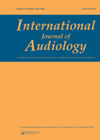
Journal Reviews
Electrocochleography and cochlear implants programming
Cochlear implants (CIs) often are the only option for people with severe to profound sensorineural hearing loss to be able to hear. Therefore, effective CI programming seems very important, especially in children who are still developing their speech. Using acoustic...
Assessment of audiological needs
A thorough assessment of audiological needs is crucial for a successful audiological rehabilitation. This study concentrated on creating the Québec Audiological Assessment Protocol for Younger and Older Adults (QAAP-YOA) that could be easily adopted in audiological clinics. The authors used...
How do mermaids hear?
When the imagery of childhood fairy tales meets the more clinically analytical mind of an adult, there may at some point come the question, ‘how do mermaids hear’? Luckily a department of biology in Denmark has sought to furnish such...
How interaural level differences differ between children with bilateral cochlear implants and their normally-hearing peers
A group in the Netherlands investigated interaural level differences (ILDs) in children who were bilaterally implanted with cochlear implants (CIs) and compared their performance to their normally-hearing peers. ILDs are used to localise sound and rely on the high-frequency cues....
Impedance for different electrode types
Measuring cochlear implant (CI) electrode impedances is common in CI programming appointments to measure the integrity of the implant e.g. whether there are any open or short electrodes. This is because impedance measures the flow of current between intra and...
Moving towards implanting children below 12 months of age
Newborn hearing screening has ensured that deaf infants are identified soon after birth so that habilitation can begin as early as possible. Cochlear implantation is a key component of early intervention for some children, but it is often not performed...
Loudness in non-organic hearing loss
Non-organic hearing loss has been of interest to researchers for a long time. In this study the authors compared a loudness rating measured in relation to the sound level for 1000 Hz in normal hearing patients and patients diagnosed with...
Cochlear implantation in asymmetric hearing loss
Criteria for cochlear implantation (CI) is a constant topic of debate. The UK traditionally had relatively restrictive guidance, although this has been greatly improved by more recent guidance released in 2019. Nevertheless, because of the lack of evidence for cost-effectiveness,...
Robotic insertion of electrode array in cochlear implantation
Cochlear implants (CIs) are commonly used for profound bilateral hearing loss. They have specific national guidance for their insertion, however patients with a substantial residual acoustic hearing are potential CI candidates. Preservation of this residual hearing can be sought with...
Algorithms to diagnose NIHL
Finding an efficient diagnostic tool for noise-induced hearing loss (NIHL) has been of research interest for a long time. There are several algorithms that compare expected age-related deterioration of hearing with the actual audiogram. This study aimed to compare a...
Cochlear implantation following radiotherapy treatment of vestibular schwannomas
The authors presented a case report and systematic review assessing the outcomes of patients from cochlear implantation (CI) following radiotherapy treatment for vestibular schwannoma (VS). Outcomes of cochlear implantation in these patients are uncertain due to the combination of both...
Alcohol and hearing
Alcohol is a well-known central nervous system depressant. Individual reactions to alcohol might vary, but the connection between alcohol consumption and tolerance to loud noise or difficulties in communication in noisy environments are well-observed phenomena; for example, at evening parties....















